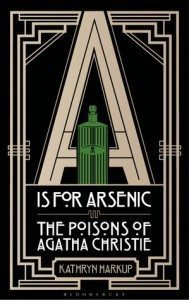 Author: Kathryn Harkup
Author: Kathryn Harkup
Release Date: September 8, 2015
Publisher: Bloomsbury USA
Source: NetGalley
Genre(s): nonfiction, mystery, reference
Rating: ★★☆☆☆
Review Spoilers: N/A
GoodReads | Amazon
This book’s intended audience is readers with a master’s degree or higher in organic chemistry or biochemistry. Without it, you’re probably going to be a very lost and an extremely bored reader. I know because I was.
I couldn’t finish this book – the material was too fact-dense and was not presented in a layman-friendly or clever manner. After what felt like two hundred pages (probably actually around fifty), I gave up.
The premise is fairly straightforward: each chapter introduced an Agatha Christie murder complete with the villain’s identity revealed (or heavily hinted at) and the means of murder disclosed.
Do not read this book if you intend to read Agatha Christie mysteries later because you will be spoiled.
The book starts with some information about Christie – she worked as an apothecary’s assistant, which made her an expert in the biochemical and medicinal properties of poisons. Hence, most of the murders in Christie’s books are fairly accurate from the timeline and administration method of the poison down to the symptoms of the victims.
One problem I did not have with this book was its format.
Each chapter contains information about a different poison, and it reads well. Not interested in arsenic? Fine. Try the chapter on Foxglove and other Nightshades. Although one chapter contains one poison, it may contain multiple novels/murders committed by the same means or approximately by the same means. For example, the family of nightshade poisons might be grouped together because they all have similar chemical properties and effects on the human body.
Unfortunately the organization was the only straight-forward part of the book.
The landslide of chem!facts dumped on the reader was not worth sifting through to find the occasional gem of chemistry knowledge that you can pretentiously break out and impress everyone at keggers. (Did you know Viagra turns your vision slightly blue??) Everything from full organic chemistry names and chemical histories to means of isolation, mechanisms, isomers, chimeric molecular diagrams, agonists, receptors, etc. are detailed (thoroughly) in this book.
So here’s the bottom line. If you’re a casual reader of Christie mysteries, do not purchase this book. However, if you need a comprehensive history of poisons and how they work, by all means, buy this book. If you want to impress your odd, misanthropic, tenured-organic chemistry professor uncle who has a thing for mystery novels with a present he’d actually like, buy this book. If you’re planning to murder someone with poison and get away with it (#HTGAWM IRL), buy this book.
It’ll probably end up putting you on some sort of watch list, but it’s better than disappointing your family this holiday season or ten to life.
Other than that, skip this one.
Final Thoughts: This book is reserved for hardcore organic chemistry nerds, not the armchair aficionado. As a biologist and a high school chemistry teacher, I have some familiarity with the topics, but I was really frustrated and bored with the endless barrage of chem!facts. I forgot if the foreword mentions this, but it bears repeating: If you don’t want your Christie mysteries spoiled, do not read this book.